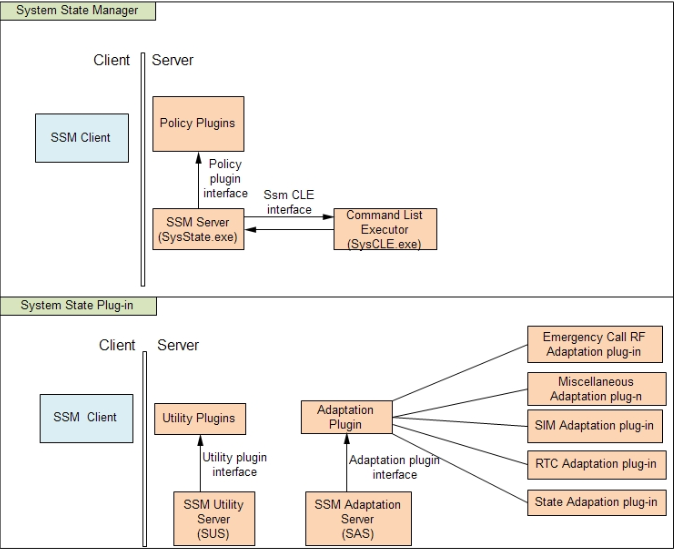System State Management Architecture Overview
This document describes the overview of the System State Management Architecture (SSMA) of the Symbian platform.
Purpose
SSMA provides a generic an a customizable mechanism to control the state of the system such as the activities to be performed at the start-up of the device, the order in which activities are executed or the actions to be performed at shut-down of the device.
Architecture
The following image shows the System State Management Architecture.
Description
System State Manager and System State Plug-in together constitute the architecture of SSMA.
The SSM client sends a state or a system wide-proeprty transition request to the System State Manager server (SysState.exe), SysState.exe loads the policy plug-in using the policy plug-in interfaces. The state policy plug-in consists of command list. The command list has the substates defined. The SysState.exe calls the command list executer using the SSM CLE interface. System Command List Executer (SysCLE) contains a list of commands that are executed by the SSM.
System State Manager Utility Server (SUS) receives a request from the SSM client. SUS is responsible to monitor and control the system-wide property changes.
SUS loads the utility plug-in using the SSM Utility plug-in interface. The policy DLL will be dynamically loaded and an object will be instantiated that will implement one of the interfaces (M Class).
System State Manager Adaptation Server (SAS) receives a request from the SSM client. SAS is responsible for security checks, admission control and multiplexing and de-multiplexing of requests to and from the adaptation plug-in interfaces.
The SSM adaptation server will create the adaptation classes by calling the first ordinal in the adaptation.dll. The different types of Adaptation plug-in are Emergency Call RF adaptation, Miscellaneous adaptation, SIM adaptation, state adaptation and RTC adaptation plug-in and use the EmergencyCallRfAdaptation, MiscAdaptation, SimAdaptation, StateAdaptation and RtcAdaptation interfaces respectively.
All the interfaces are implemented by the corresponding R classes exposed from the SSM adaptation server. This allows custom commands and other components in the system with appropriate capabilities to access the functionality provided in these adaptation interfaces.
Components
System State Manager: System State Manager (SSM) is a Symbian platform component that manages the state of a system throughout its lifecycle. The SSM extends the existing Generic Start-up Architecture (GSA) to manage the whole system lifecycle.
System State plug-in: The system state plug-in framework provides interfaces suitable for interpreting the conditional resource files. It also provides interfaces which allow customisation of the behaviour of state and system wide property changes.
Copyright ©2010 Nokia Corporation and/or its subsidiary(-ies).
All rights
reserved. Unless otherwise stated, these materials are provided under the terms of the Eclipse Public License
v1.0.
